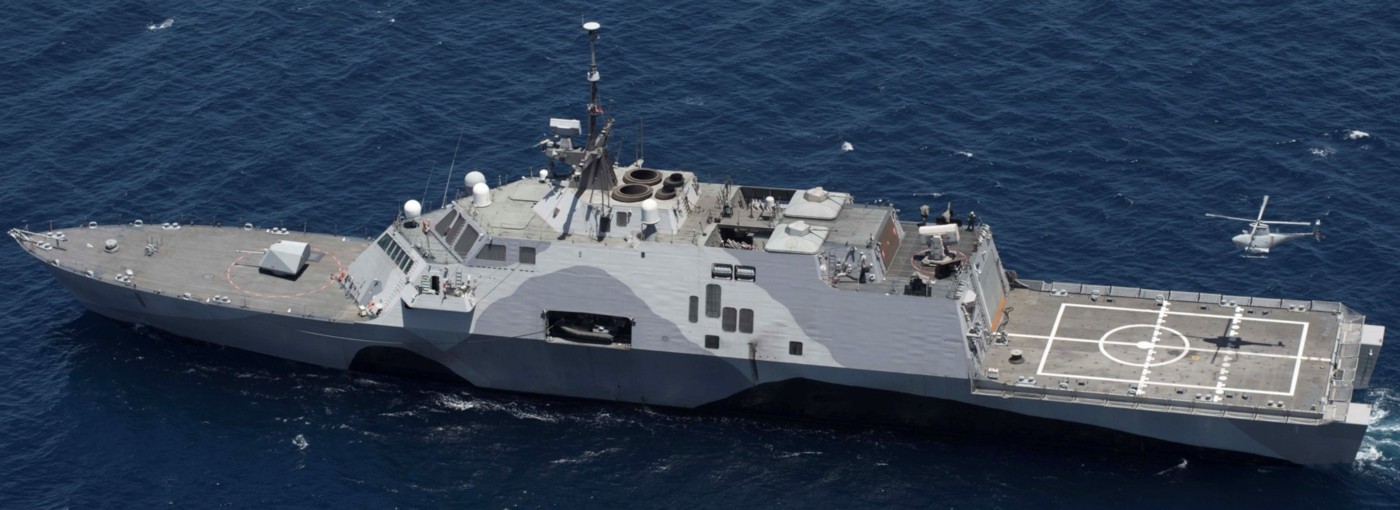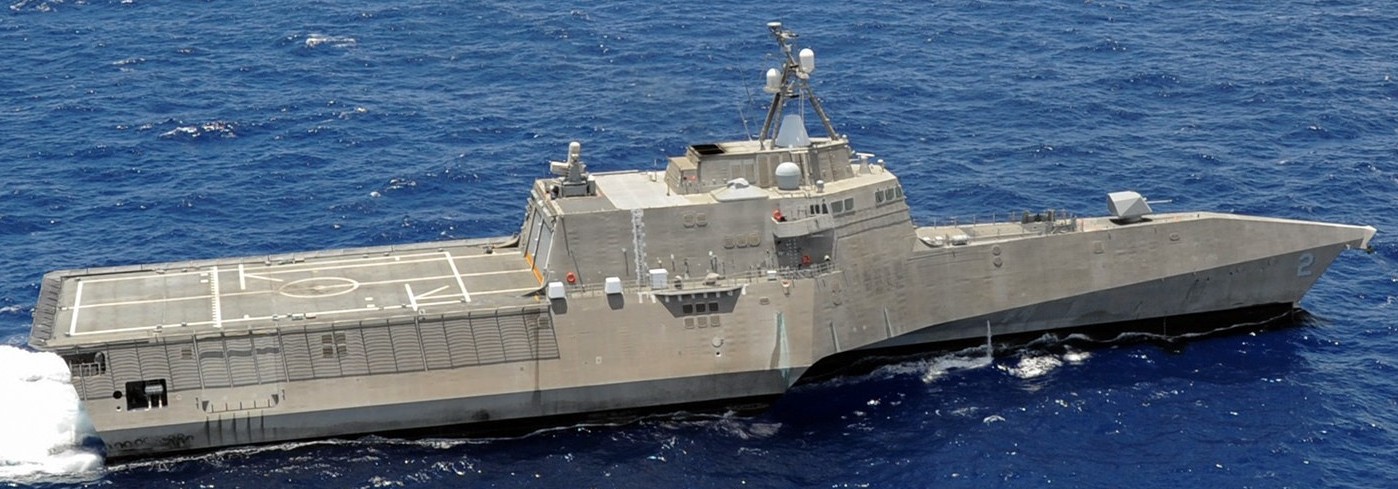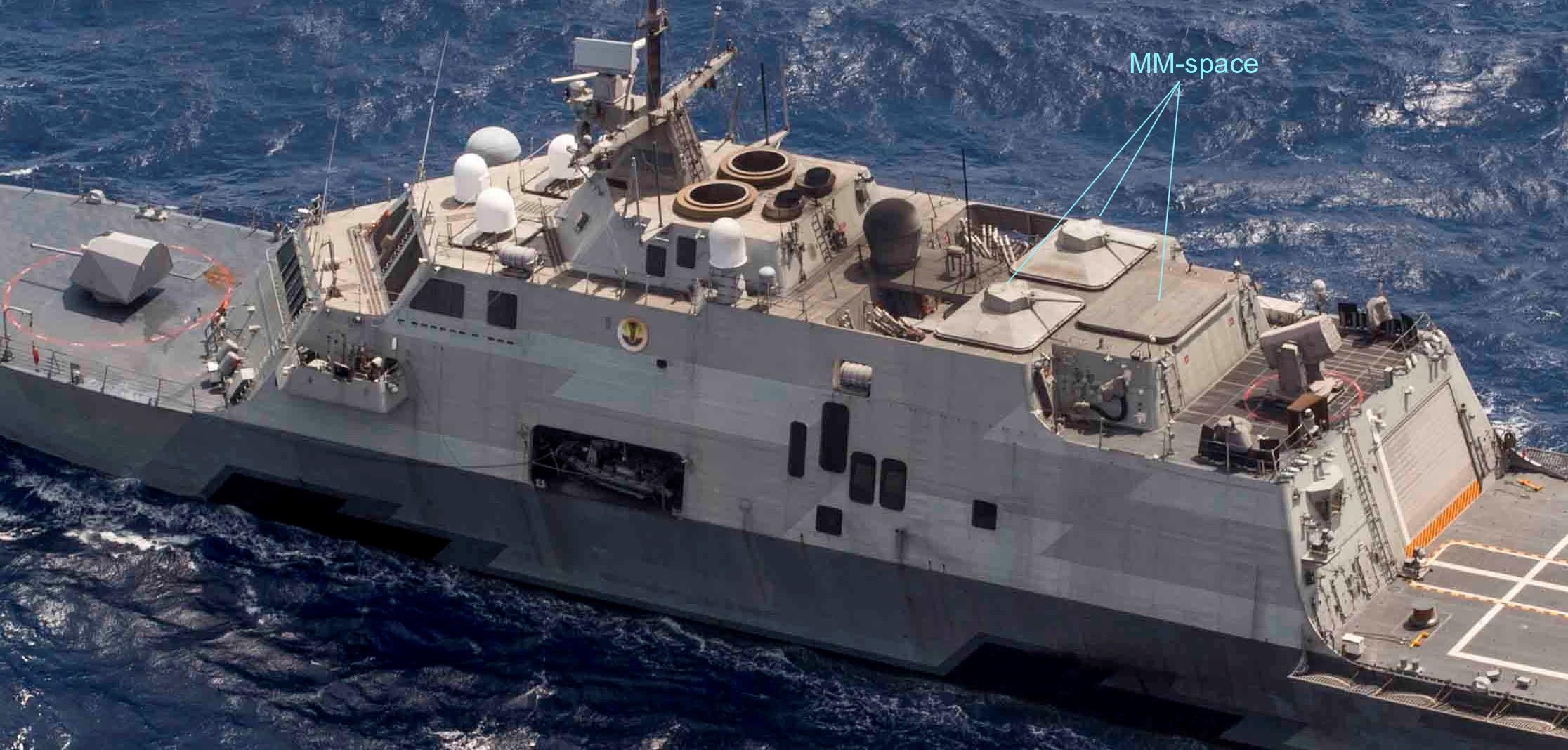|
|
|
HOME
|
US Navy -
ships
|
US Navy - air
units
|
USMC - air
units
|
International
Navies
|
Weapon Systems
|
Special Reports |
|
Surface Vessel Weapon System LCS mission modules (mission modules for Freedom & Independence class Littoral Combat Ships) |

 |
|
Description: The Littoral Combat Ship (LCS) is a fast, agile, and networked surface combatant, optimized for operating in the littorals. The primary missions for the LCS include countering diesel submarine threats, littoral mine threats, and surface threats, such as small surface craft attacks, to assure maritime access for Joint forces. The underlying strength of the LCS lies in its innovative design approach, applying modularity for operational flexibility. Fundamental to this approach is the capability to rapidly install interchangeable mission packages (MPs) onto the seaframe. Each mission package can be quickly installed aboard an LCS to fulfill a specific mission, and then be uninstalled, maintained, and upgraded at a Mission Package Support Facility (MPSF) for future use aboard any LCS seaframe. Features: Each Mission Package (MP) provides unique warfighting capabilities for one of three focused mission areas. • Mine Countermeasure (MCM) – detection and neutralization of mine threats. • Surface Warfare (SUW) – maritime security and prosecution of small boat threats. • Anti-Submarine Warfare (ASW) – detect, classify, localize and prosecute enemy submarines. These unique capabilities will be supported by the LCS Mission Package Support Facility (MPSF), located in Naval Base Ventura County, Calif. Due to the LCS seaframe’s flexibility to rapidly switch mission capabilities, the MPSF plays the integral role of primary responder for all seaframe-embarked mission packages. The MPSF will address afloat maintenance issues and provide technical support for the Mission Module Sailors. The MPSF will also have a virtual presence via distance support to provide “round-the-clock” services for all deployed LCS Mission Modules and will ensure LCS’ ability to reconfigure mission packages according to operational demand. Mission systems fit inside standard ten- or twenty-foot International Organization for Standardization (ISO) support containers (SCs), or on ISO compliant flat racks and vehicle cradles. Using ISO SCs simplifies shipping, storage, availability of correct handling equipment, and container movement from shore to ship and ship to shore. MP reconfiguration will occur in homeport or overseas, using pre-positioned MPs or MPs that have been transported into theater by air, land, or sea and staged near the LCS operating area. Background: A Mission Package consists of Mission Modules (MMs), mission crew detachments, and support aircraft. A MM combines mission systems (vehicles, sensors, communications and weapon systems), support equipment, Mission Package Computing Environment (MPCE) hardware and software, and Multiple Vehicle Communications System (MVCS) hardware and software, which installs into the seaframe via standard interfaces. The MPCE provides the local information technology (IT) infrastructure for MP operations and the required network interfaces to the Total Ship Computing Environment (TSCE) on the LCS seaframe. It is the primary interface that enables the mission package to work on the ship. The MPCE is a permanently installed equipment shipset in each seaframe. The hierarchal MP concept is best described in three layers: • Mission Systems = Vehicles, Sensors, and Weapons • Mission Module = Mission Systems + Support Equipment • Mission Package = Mission Modules + Mission Crew Detachments + Aircraft Mission packages can be swapped in order to reconfigure the ship for a different mission in a short period of time, giving a Combatant Commander a uniquely flexible response to changing warfighting requirements. Package reconfiguration can occur in homeport or overseas, using pre-positioned mission packages or mission packages transported into theater by air or sea and staged near the LCS operating area. To achieve this flexibility, the Navy is developing and procuring mission packages to meet the Joint warfighting requirements. The quantity of each mission package type differs based on an analysis of projected operational needs; therefore, mission packages are developed and procured separately from the LCS seaframes. Currently, the Navy plans to procure 55 LCS ships as well as 16 Anti-Submarine Warfare (ASW) mission packages, 24 Mine Countermeasures (MCM) mission packages, and 24 Surface Warfare (SUW) mission packages. This allows the LCS warfighting capability to quickly adapt to evolving threats using improved technology. This concept also helps to reduce the overall cost of the LCS and will allow a smaller crew who continuously operate and maintain the seaframe and its core systems. • Mine Countermeasure (MCM) - detection and neutralization of mine threats: The first increment of the MCM Mission Package represents a major step towards achieving the Navy’s goal of providing organic mine countermeasures for strike groups. Future Joint Force Commanders will have forces at their disposal to conduct MCM operations - ranging from first response mine detection through neutralization and influence mine sweeping - before the arrival of joint power projection forces. As they join the Fleet, LCSs will assume more of the Navy’s responsibilities for MCM missions. MCM configured LCSs will perform MCM operations in ways that are significantly different from the Navy’s current inventory of mine hunters and sweepers. Today’s mine warfare ships were designed to operate inside a minefield. Conversely, the function of the MCM-equipped LCS is predominately to transport and deploy manned and unmanned off board surface and semi-submersible vehicles with MCM sensors and systems to the vicinity of the minefield, while remaining outside the mine threat area itself. This approach ensures that the mine threat is neutralized while keeping the Sailors out of the minefield. A suite of off board sensors and systems will be used to detect, localize, neutralize and, if necessary, sweep mines. • Surface Warfare (SUW) – maritime security and prosecution of small boat threats: The SUW Mission Package (MP) provides fleet protection from small boats and other asymmetrical threats. The package can also be used to provide operational security in interdiction missions against terrorist suspects and high seas pirates, and can provide defense against shore attacks while operating in the littorals. These capabilities, when joined together, permit the ship’s crew and the fleet commander to operate with confidence and address threats to the fleet while operating in the littorals and in constrictive environments. The SUW MP augments the core Littoral Combat Ship (LCS) sensor and weapons capabilities with gun, missile, and aviation systems, providing a layered defense capable of rapidly detecting, tracking, and prosecuting small boat threats. Ultimately, this package enhances the safety of the Sailors while permitting the mission commander to maintain operational flexibility. The Baseline SUW MP will include: • Gun Mission Module EX 50 MOD 0 - MK-46 Gun Weapon System with MK-44 30mm Automatic Cannon - Uses all Navy qualified 30mm×173mm ammunition - 400 rounds in turret - Two ready service magazines with 240 rounds each - Three shipping containers • Surface-to-Surface Missile Module (SSMM) - Surface-to-surface missiles capable of engaging fast-moving small boat threats - Launcher system with self-contained technical fire control - Hatch system / support structure / module service panels - Gas management system - Modular control computer • Aviation Module MH-60R Helicopter - MK-299 MOD.2 launchers with 8 HellFire missiles - GAU-21 .50 caliber machine gun - M240 7.62mm machine gun - Two support containers - Vertical Takeoff Unmanned Aerial Vehicle (2) - One support container • Maritime Security Module - Two 11m Rigid Hull Inflatable Boats (RHIBs) with cradles and parts - Two Berthing modules with gear storage - One head and shower module - Visit, Board, Search, and Seizure (VBSS) gear - Boarding teams • Mission Package Application Software - Mission specific application software that supports the MP in planning and executing the SUW Missions. The first LCS deployment, from February to April 2010, featured the SUW MP configuration. USS Freedom (LCS 1) deployed with two Gun Mission Modules, Mission Package Application Software (MPAS) hosted on the ship’s Mission Package Computing Environment (MPCE), a MH-60S helicopter, the Maritime Security Module (MSM), support containers, and Sailors. LCS 1 operated within the U.S. Naval Forces Southern Command (NAVSO)/U.S. 4th Fleet (C4F) in the U.S. Southern Command (USSOUTHCOM) Area of Responsibility (AOR). The SUW MP proved to be extremely successful throughout the deployment. During its 47 days operating in the region, U.S.S. Freedom conducted counter-illicit trafficking patrols in the Caribbean Sea and off the coasts of Central and South America, in support of Joint Interagency Task Force-South, USSOUTHCOM, and the U.S. Coast Guard, with the SUW MP Gun Mission Module (GMM) fully operational. • Anti-Submarine Warfare (ASW) – detect, classify, localize and prosecute enemy submarines: An LCS equipped with an ASW Mission Package (MP) provides the Joint Force Commanders with the capability to conduct detect-to-engage operations against modern diesel-electric and nuclear submarines in littoral areas and defeat those that pose an immediate threat. The capability enables operational commanders assured access in contested, anti-access, and area denial littoral environments. Specific ASW capabilities include protecting forces in transit, protecting joint operating areas, and establishing ASW barriers. The LCS ASW mission is to conduct ASW operations in support of a carrier strike group (CSG) or amphibious readiness group (ARG), or while operating as part of an LCS surface action group (SAG) or independently. This will allow for the protection of CSG and ARG operating areas, the establishment of ASW barriers, and the escort of high-value units (HVUs) into and within theater. These efforts must be effective in the shallow littoral as well as in the deep water approaches to the littorals. Features: A second generation (Spiral BRAVO) ASW Mission Package is under development for delivery in the 2016 timeframe. Planned components include: ASW Escort Module • Variable depth sonar (VDS) • Multi-function towed array (MFTA) acoustic receiver • Launch, handling and recovery equipment • Signal processing and systems control • Support containers Torpedo Defense Module • Alertment: MFTA with Acoustic Intercept (ACI) • Countermeasures: Light Weight Tow (LWT) Aviation Module • MH-60R Helicopter w/ALFS • Vertical Takeoff Unmanned Aerial Vehicle (2) • Support containers ASW Mission Management / C2 Center • Mission package application software • Networks that interface with the total ship computing environment Used on: Freedom class LCS Independence class LCS |
|
images |
 Freedom class LCS with 2 Gun Mission Modules EX-50 Mod.0 (MK-46 Gun Weapon System)  Independence class LCS with 2 Gun Mission Modules EX-50 Mod.0 (MK-46 Gun Weapon System) |
|
|
seaforces.org
|
Weapon Systems
start page
| |
